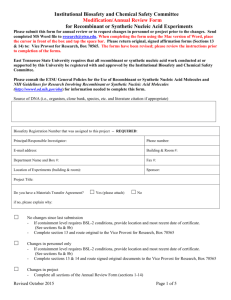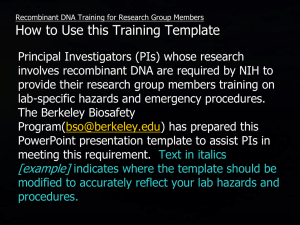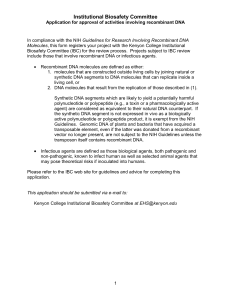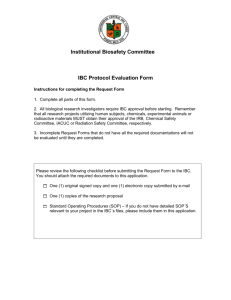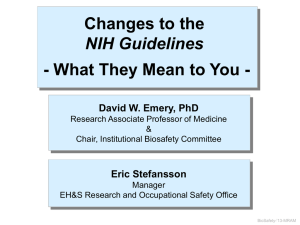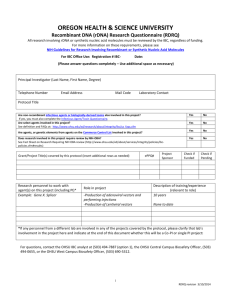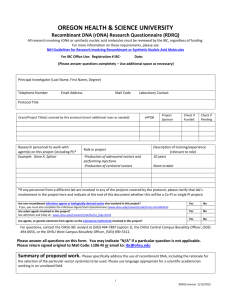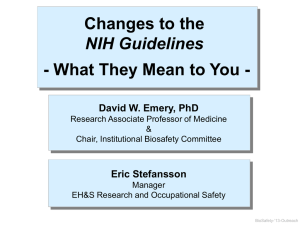Registration for the Use of Biological Materials
advertisement
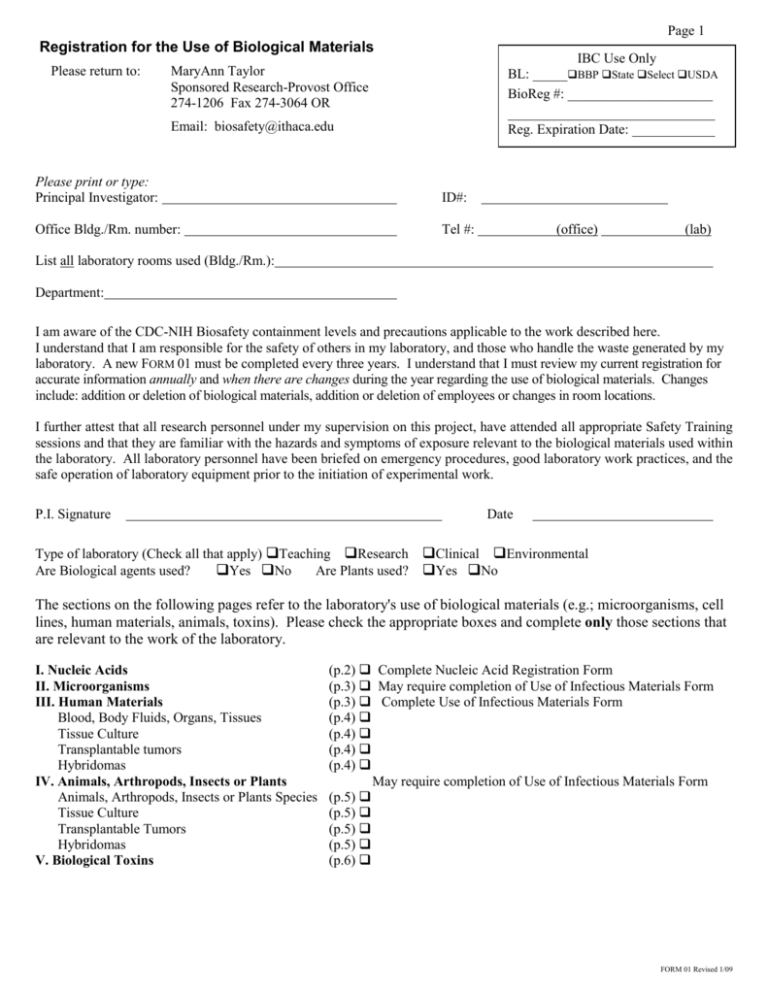
Page 1 Registration for the Use of Biological Materials Please return to: IBC Use Only BL: _____BBP State Select USDA BioReg #: _____________________ ______________________________ Reg. Expiration Date: ____________ MaryAnn Taylor Sponsored Research-Provost Office 274-1206 Fax 274-3064 OR Email: biosafety@ithaca.edu Please print or type: Principal Investigator: ID#: Office Bldg./Rm. number: Tel #: (office) (lab) List all laboratory rooms used (Bldg./Rm.): Department: I am aware of the CDC-NIH Biosafety containment levels and precautions applicable to the work described here. I understand that I am responsible for the safety of others in my laboratory, and those who handle the waste generated by my laboratory. A new FORM 01 must be completed every three years. I understand that I must review my current registration for accurate information annually and when there are changes during the year regarding the use of biological materials. Changes include: addition or deletion of biological materials, addition or deletion of employees or changes in room locations. I further attest that all research personnel under my supervision on this project, have attended all appropriate Safety Training sessions and that they are familiar with the hazards and symptoms of exposure relevant to the biological materials used within the laboratory. All laboratory personnel have been briefed on emergency procedures, good laboratory work practices, and the safe operation of laboratory equipment prior to the initiation of experimental work. P.I. Signature Date Type of laboratory (Check all that apply) Teaching Research Clinical Environmental Are Biological agents used? Yes No Are Plants used? Yes No The sections on the following pages refer to the laboratory's use of biological materials (e.g.; microorganisms, cell lines, human materials, animals, toxins). Please check the appropriate boxes and complete only those sections that are relevant to the work of the laboratory. I. Nucleic Acids II. Microorganisms III. Human Materials Blood, Body Fluids, Organs, Tissues Tissue Culture Transplantable tumors Hybridomas IV. Animals, Arthropods, Insects or Plants Animals, Arthropods, Insects or Plants Species Tissue Culture Transplantable Tumors Hybridomas V. Biological Toxins (p.2) Complete Nucleic Acid Registration Form (p.3) May require completion of Use of Infectious Materials Form (p.3) Complete Use of Infectious Materials Form (p.4) (p.4) (p.4) (p.4) May require completion of Use of Infectious Materials Form (p.5) (p.5) (p.5) (p.5) (p.6) FORM 01 Revised 1/09 Page 2 I. Nucleic Acids: 1. Does your lab isolate, process, store, or use nucleic acids? Yes No 2. Does your laboratory perform any Recombinant DNA experiments? Yes No 3. If yes, are your Recombinant DNA experiments exempt from NIH guidelines? Yes No (see checklists below) 4. Does your lab use synthetic nucleic acids of any kind, and, if so, briefly describe their uses in your lab? Yes No a. DNA b. RNA Please complete the applicable sections of the IC nucleic acid registration form. NIH Guidelines for exempt experiments involving recombinant or synthetic nucleic acids Section III-F. Exempt Experiments The following recombinant or synthetic nucleic acid molecules are exempt from the NIH Guidelines and registration with the Institutional Biosafety Committee is not required; however, other federal and state standards of biosafety may still apply to such research (for example, the Centers for Disease Control and Prevention (CDC)/NIH publication Biosafety in Microbiological and Biomedical Laboratories). Section III-F1. Those synthetic nucleic acids that: (1) can neither replicate nor generate nucleic acids that can replicate in any living cell (e.g., oligonucleotides or other synthetic nucleic acids that do not contain an origin of replication or contain elements known to interact with either DNA or RNA polymerase), and (2) are not designed to integrate into DNA, and (3) do not produce a toxin that is lethal for vertebrates at an LD50 of less than 100 nanograms per kilogram body weight. If a synthetic nucleic acid is deliberately transferred into one or more human research participants and meets the criteria of Section III-C, it is not exempt under this Section. Section III-F-2. Those that are not in organisms, cells,or viruses and that have not been modified or manipulated (e.g., encapsulated into synthetic or natural vehicles) to render them capable of penetrating cellular membranes. Section III-F-3. Those that consist solely of the exact recombinant or synthetic nucleic acid sequence from a single source that exists contemporaneously in nature. Section III-F-4. Those that consist entirely of nucleic acids from a prokaryotic host, including its indigenous plasmids or viruses when propagated only in that host (or a closely related strain of the same species), or when transferred to another host by wellestablished physiological means. Section III-F-5. Those that consist entirely of nucleic acids from a eukaryotic host including its chloroplasts, mitochondria, or plasmids (but excluding viruses) when propagated only in that host (or a closely related strain of the same species). Section III-F-6. Those that consist entirely of DNA segments from different species that exchange DNA by known physiological processes, though one or more of the segments may be a synthetic equivalent. A list of such exchangers will be prepared and periodically revised by the NIH Director with advice of the RAC after appropriate notice and opportunity for public comment (see Section IV-C-1-b-(1)-(c), Major Actions). See Appendices A-I through A-VI, Exemptions under Section III-F-6--Sublists of Natural Exchangers, for a list of natural exchangers that are exempt from the NIH Guidelines. Section III-F-7. Those genomic DNA molecules that have acquired a transposable element, provided the transposable element does not contain any recombinant and/or synthetic DNA. Section III-F-8. Those that do not present a significant risk to health or the environment (see Section IV-C-1-b-(1)-(c), Major Actions), as determined by the NIH Director, with the advice of the RAC, and following appropriate notice and opportunity for public comment. See Appendix C, Exemptions under Section III-F-8for other classes of experiments which are exempt from the NIH Guidelines. Checklist To Determine Whether Tissue Culture Experiments Are Exempt From The Recombinant DNA Guidelines Many tissue experiments with recombinant DNA molecules are exempt from the NIH Guidelines. If the answers to all 5 of the following questions are no, then the tissue culture experiments are exempt according to Appendix C-I. Yes No Do any recombinant DNA molecules contain one-half or more of any eukaryotic viral genome? Do any experiments involve Risk Groups 2, 3, 4 or restricted organisms or nucleic acids from Risk Groups 3, 4 or restricted organisms? Do any experiments involve introduction of genes coding for molecules toxic for vertebrates? Do any experiments involve infectious viruses? Do any experiments involve defective viruses in presence of helper viruses? FORM 01 Revised 1/09 Page 3 Checklist To Determine Whether Experiments With E.coli K12 And Yeast Are Exempt From The Recombinant DNA Guideline Most experiments involving E. coli K-12 host vector systems and Saccharomyces cerevisiae and Saccharomyces uvarum host vector systems are exempt from the NIH Guidelines. If the answers to all 3 of the following questions are no, then the experiments are exempt according to Appendix C-II (for E. coli K-12) or Appendix C-III (for Saccharomyces cerevisiae and Saccharomyces uvarum). Yes No Do any experiments involve Risk Groups 2, 3, 4 or restricted organisms or nucleic acids from Risk Groups 3, 4 or restricted organisms? Do any experiments involve introduction of genes coding for molecules toxic for vertebrates? Will there be any large-scale experiments (more than 10 liters of culture)? Checklist To Find Relevant Section Of The Recombinant DNA Guidelines Section III-D: Experiments that require IBC approval before initiation. Section III-E: Experiments that require IBC notice simultaneous with initiation. Yes No Is any human or animal pathogen (defined as a Risk Group 2, Risk Group 3, Risk Group 4, or Restricted Agents) used as either the host organism or as a vector? Section III-D-1 Is any DNA from Risk Group 2, Risk Group 3, Risk Group 4, or Restricted Agents cloned into nonpathogenic prokaryotic or lower eukaryotic host-vector systems? Section III-D-2 Do recombinant DNA or RNA experiments involve the use of infectious animal or plant viruses in tissue culture systems? Section III-D-3 Do recombinant DNA or RNA experiments involve the use of defective animal or plant viruses in the presence of helper virus in tissue culture systems? Section III-D-3 Do recombinant DNA experiments involve whole animals (Section III-D-4) or plants (Section III-D-5)? Do experiments involve more than 10 liters of culture? Section III-D-6 Section III-E: Catchall section for experiments that are not exempt but are not covered in other sections. Note: Transgenic or knockout rodent experiments that require BL1 containment may be initiated simultaneously with IBC notification. The purchase of transgenic rodents for BL1 experiments is exempt from the NIH Guidelines. Section III-A: Experiments that require IBC, RAC Review and NIH Director approval before initiation. Section III-B: Experiments that require NIH/ORDA and IBC approval before initiation. Section III-C: Experiments that require IRB and IBC approval and NIH/ORDA Registration before initiation. Yes No III-A-1: Transfer of drug resistance trait to organism that does not acquire it normally (if it could compromise the use of the drug to control disease agents in humans, animal or agriculture). III-B-1: Formation of recombinant DNAs containing genes coding for the synthesis of molecules toxic for vertebrates. III-C-1: Human gene transfer experiments. FORM 01 Revised 1/09 Page 4 II. MICROORGANISMS Opportunistic Human Pathogen Animal Pathogen Plant Pathogen Non-pathogenic Strain (if known) Human Pathogen Agent (list Genus and Species) Risk Group All Bldg./rms. where used/stored Biosafety Level 1, 2, 3, 4 III. HUMAN MATERIALS Does your laboratory examine any specimens for the purpose of providing information to physicians? Yes [ ] No [ ] If yes, what type of organisms do you normally look for? What are the test results used for? research diagnostic purposes treating patients Containment at Biosafety Level 1 2 3 4 (check one) Human Material Type/Source (applicable) All Bldg./rms. where used/stored Blood Body Fluids Organs Tissues For additional materials, please use separate sheet. FORM 01 Revised 1/09 Page 5 Tissue Culture 1 2 3 4 (check one) Containment at Biosafety Level Primary Cell Lines/Continuous Cell Lines (please indicate) Source Bldg./Rm. where used/stored For additional materials, please use separate sheet. Transplantable tumors Tumor/Description Containment at Biosafety Level Institutional source 1 2 3 4 (check one) Animal or Containment Bldg./Rm. where Tissue culture test date used/stored For additional materials, please use separate sheet. Hybridoma Carrier cell line Containment at Biosafety Level In vivo/In vitro Specify animals used 1 2 3 4 (check one) Bldg./Rm. where used/stored/housed For additional materials, please use separate sheet. IV. ANIMALS, ARTHROPODS, INSECTS OR PLANTS Containment at Biosafety Level Live Animal (incl. birds, etc.), Arthropods, Insects or Plants 1 2 3 4 (check one) Handlers (list primary responsibility first. If for a class, list the course number and title) Bldg./rms. housed FORM 01 Revised 1/09 Page 6 Animal, Arthropods, Insects or Plants Products or Materials (include preserved items here Tissue Culture Handlers (list primary responsibility first. If for a class, list the course number and title) 1 2 3 4 (check one) Containment at Biosafety Level Cell line Bldg./rms. housed Source Bldg./Rms. where used/stored For additional materials, please use separate sheet. Transplantable tumors 1 2 3 4 (check one) Containment at Biosafety Level Tumor/Description Institutional source Animal or Tissue culture Containment test date Bldg./Rms. where used/stored For each tumor, please list all potential handlers below: Hybridoma Carrier cell line Containment at Biosafety Level In vivo/In vitro Specify animals used 1 2 3 4 (check one) Bldg./Rms. where used/stored/housed For additional materials, please use separate sheet.: FORM 01 Revised 1/09 V. BIOLOGICAL TOXINS (active) Type of Toxin Experimental Concentration Containment at Biosafety Level Supplier Page 7 1 2 3 4 (check one) Toxin LD50 Human Animal All Bldg./rms. where used/stored Abrin Aflatoxins Amanitin Bacterial Toxins (specify toxin): Bee Venoms *Botulinum Toxins Castorbean Clostridium perfringens epsilon toxin Conotoxins Diacetoxyscirpenol Insect Toxins Lectins Mycotoxins Ricin *Ricin D Saxitoxin Shigatoxin Staphylococcal enterotoxins Snake venoms Tetrodotoxin *Tetrodotoxin citrate, 2 hydroxy T-2 toxin Other(specify toxin): *Botulinum toxins, Ricin D, and Tetrodotoxin citrate, 2 hydroxy… have LD50 values <100ng/kg body weight and are non-exempt. CDC Select Agent Rule (42 CFR Part 72) requires registration of facilities with CDC for their use, storage and transfers. For additional toxins, please use separate sheet. Antidote available yes no Source Antidote in your possession yes no Plan to inactivate toxin FORM 01 Revised 1/09 Page 7 of 7

